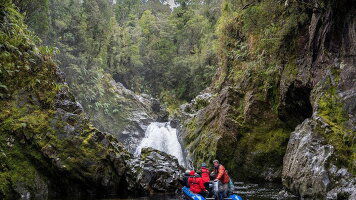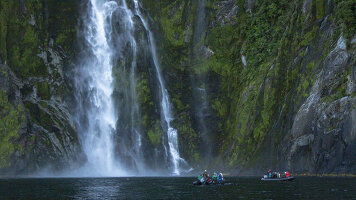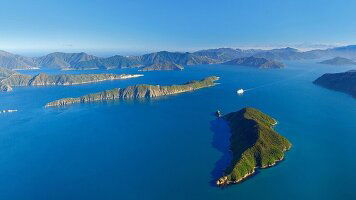
Overview
Heritage Expeditions is the most experienced Southern Ocean operator, and the only Australasian family-owned and operated cruise company, and have been exploring the Subantarctic Islands for more than 35 years. This is one of our ‘signature expeditions' ensuring you will benefit from our unrivalled knowledge and expertise of the region.
Departing the Port of Bluff, Invercargill, the first of these islands we visit is Campbell Island, the southernmost island of this expedition, is an example of what can be achieved in restoring islands. In recent years sheep, cattle, cats and rats have all been eliminated and the island is rapidly recovering. The great English botanist Sir Joseph Hooker, a friend of Charles Darwin, visited Campbell Island in the 1840s and described the flowering fields of ‘megaherbs' to be a flora display "second to none outside of the tropics". We can say the same now, because of the removal of these introduced animals. This island is also the home of the majestic Southern Royal Albatross, the endemic Campbell Island Flightless Teal and Snipe.
In the Auckland Islands, the largest of the island groups, we will have the chance to spend the day ashore on Enderby Island, arguably the most amazing Subantarctic Island. Here you can hike through the windswept Rata forests, and along the exposed coastal cliffs. The wildlife is never far away and its lack of fear means close encounters, great for photography and observations. In Carnley Harbour in the south of the Auckland Islands there are a number of fascinating sites, including a Shy Albatross colony, abandoned Coastwatcher's huts, a shipwreck and castaway depots that we can visit. The weather will dictate what we do.
Our adventure then takes us to The Snares, where no landings are permitted because the islands are honey-combed with seabird burrows. Of particular interest are the Snares Crested Penguin, Fernbird and Tomtit - all of which are endemic. We should see them all as we enjoy the dramatic coastline and tree daisy forest from our Zodiac cruise.
These islands represent a priceless ecosystem. Joining this expedition redefines natural history travel and will leave you wishing you could have spent more time there. Our December 2025 voyage includes the option to join a sea kayaking excursion with an expert guide. Kayaking around the Subantarctic Islands offers a wide array of habitats to explore beyond the reach of our Zodiacs.
Itinerary
Guests should make their way to the designated hotel where we will spend the first night of the expedition.
This evening there will be an informal get-together at the hotel for dinner; an excellent opportunity to meet fellow adventurers on your voyage and some of our expedition team. Please note: The 27 December 2026 voyage includes a hotel night in Invercargill instead of Queenstown. Guests should make their way to the designated hotel in Invercargill where we will spend the first night of the expedition, or join our 3pm Queenstown transfer from a designated meeting point to Invercargill.
Today we enjoy breakfast in the hotel restaurant and have the morning free to explore Queenstown before returning to the hotel for lunch and departing for the Port of Bluff to embark your ship. You will have time to settle into your cabin and familarise yourself with the ship; we will also take the opportunity to conduct a number of safety briefings.
You are invited to join the expedition team in the Observation Lounge and up on the Observation Deck as we set our course to Campbell Island and our adventure begins. We will sail past Ruapuke Island, formerly a local Maori stronghold supporting a population of over 200 people. We will also be able to see Stewart Island. Despite appearing quite small on most maps it is really quite large and has a 700 kilometre coastline. Seabirds that we may encounter at this early point in the voyage include: albatross, petrels, cormorants, gulls and Little Blue Penguins.
As we make our way through the Southern Ocean we take the opportunity to learn more about the flora and fauna as we prepare for our arrival at Campbell Island. En route there are great birding opportunities which may include the Wandering Albatross, Royal Albatross, Black-browed Albatross, Light-mantled Sooty Albatross, Salvin's Albatross, Campbell Island Albatross, Northern and Southern Giant Petrel, Sooty Shearwater and Little Shearwater. There should be plenty of petrels and again the hard to identify prion species. We can expect some of the best pelagic birding on this leg of the journey from Bluff to Campbell Island with great views during the crossing.
We have a full day to explore Campbell Island, New Zealand's southernmost Subantarctic territory. Its history is as rich and varied as the other islands we visit. Discovered in 1810, it was soon occupied by sealers who introduced rats and cats. Farming followed from 1895 to 1934 when it was abandoned. Coastwatchers were stationed on the island during the war and at the end of the war the station was taken over by the New Zealand Metrological service. They maintained a manned weather/ research station there until 1995.
In the early 1970s the removal of farm animals commenced and all were eventually removed by 1990. The vegetation recovered quickly and the cats died out naturally. In a very ambitious (and never before attempted on such a large scale) eradication programme the New Zealand Department of Conservation successfully removed the rats. With the island declared predator free, the way was clear to reintroduce the endangered Campbell Island Flightless Teal, which had been rediscovered on an offshore island in 1975. Snipe, which were formerly unknown from the island but were discovered on another offshore island, recolonised the islands themselves.
The vegetation which the great English botanist Sir Joseph Hooker described in 1841 as having a “Flora display second to none outside the tropics” is flourishing and is nothing short of spectacular. We will offer a number of options which will enable you to explore the island including an extended walk to Northwest Bay. There will also be an easier walk to the Col Lyall Saddle. All of these options will allow you the opportunity and time to enjoy the Southern Royal Albatross which nest here in large numbers. We also visit areas of the island which contain outstanding examples of the megaherbs for which the island is renowned.
In the south of the archipelago there is a very large sheltered harbour rich in human history including shipwrecks, treasure hunters, Coastwatchers and, of course, scientific parties. We plan to arrive mid-morning entering the harbour through the eastern entrance which is guarded on both sides by dramatic cliffs and climb there will be an opportunity to Zodiac cruise along the coast of Adams Island, Western Harbour and Victoria Passage. Other options include the Tagua Bay Coastwatcher's hut and lookout which was occupied during the Second World War.
We could visit Epigwatt and the remains of the Grafton which was wrecked here in 1864. All five men aboard survived and lived here for 18 months before sailing their modified dinghy to New Zealand to get help. Two of the survivors wrote books about their ordeal, their first-hand accounts tell us a lot about their time here.
Later this evening we will sail up the eastern coast, making our way to Port Ross in preparation for our landing at Enderby Island.
The Auckland Islands group was formed by two volcanoes which erupted some 10-25 million years ago. They have subsequently been eroded and dissected by glaciation creating the archipelago as we know it today. Enderby Island is one of the most beautiful islands in this group and is named after the same distinguished shipping family as one of our former vessels. This northern most island in the archipelago is an outstanding wildlife and birding location and is relatively easy to land on and walk around.
The island was cleared of all introduced animals (pests) in 1994 and both birds and the vegetation, especially the herbaceous plants, are recovering both in numbers and diversity. Our plan is to land at Sandy Bay, one of three breeding areas in the Auckland Islands for the Hooker's or New Zealand Sea Lion, a rare member of the seal family.
Beachmaster bulls gather on the beach, defending their harems from younger (ambitious) males, to mate with the cows shortly after they have given birth to a single pup. Hooker's or New Zealand Sea Lion numbers are in a slow decline, for reasons which are not obvious but most probably connected with a nearby squid fishery. During our day ashore there will be several options, some longer walks, some shorter walks and time to spend enjoying the wildlife.
The walking is relatively easy. A boardwalk traverses the island to the dramatic western cliffs, from there we follow the coast and circumnavigate the island. Birds that we are likely to encounter include the following species: Southern Royal Albatross, Northern Giant Petrel, Auckland Island Shag, Auckland Island Flightless Teal, Auckland Island Banded Dotterel, Auckland Island Tomtit, Bellbird, Pipit, Red-crowned Parakeet, Yellow-eyed Penguin and Light-mantled Sooty Albatross. There is also a very good chance of seeing the Subantarctic Snipe. Other more common species we will see include the Goldfinch, Song Thrush, Blackbird, European Starling, Red-billed Gull and Redpoll. On Derry Castle Reef we will look for migratory waders which could include Bar-tailed Godwit, Turnstone and possibly vagrants.
The closest Subantarctic Islands to New Zealand, they were appropriately called The Snares as they were once considered a hazard for sailing ships. Comprising of two main islands and a group of five islands called the Western Chain; they are uninhabited and enjoy the highest protection as Nature Reserves. It is claimed by some that these islands are home to more nesting seabirds than all of the British Isles together. We plan to arrive in the morning, and as landings are not permitted, we will Zodiac cruise along the sheltered eastern side of the main island if the weather and sea conditions are suitable.
In the sheltered bays, we should see the endemic Snares Crested Penguin, Snares Island Tomtit and Fernbirds. There are hundreds of thousands of Sooty Shearwaters nesting on The Snares; the actual number is much debated. Buller's Albatross breed here from early January onwards. There will be opportunities to view the forests of large tree daisy Olearia lyallii which forms a canopy over much of the island group.
Tonight we enjoy a farewell and celebratory dinner with newfound friends with time to reflect on a wealth of new experiences and recap on what amazing wildlife, plant life, landscapes and history we have enjoyed.
Spend the morning exploring Stewart and Ulva Islands. Rich in history and wildlife, Ulva Island has been predator-free since 1997 and its bird song and wildlife is some of the best in New Zealand. Say your farewells be transferred to either Invercargill or Queenstown Airport. In case of unexpected delays, we ask you not to book any onward travel from Invercargill before 3pm or before 6pm from Queenstown. Note: During our voyage, circumstances may make it necessary or desirable to deviate from the proposed itinerary.
This can include poor weather and opportunities for making unplanned excursions. Your Expedition Leader will keep you fully informed. Landings at the Subantarctic Islands of New Zealand are by permit only as administered by the Government of New Zealand. No landings are permitted at The Snares.
Life Onboard Heritage Adventurer
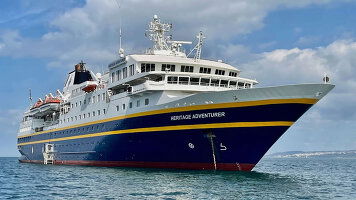
Built for polar exploration with a great track record, guests cruise in comfort onboard the Heritage Adventurer. Read more
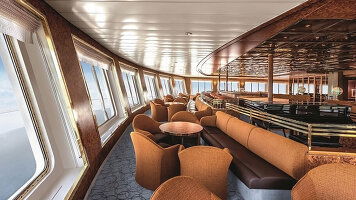
Sit back and enjoy a drink in the Observation Lounge, or experience 360-degree views from the Observation Deck. Read more

To make sure every guest has an elevated experience, Heritage Adventurer comes ready with a fleet of 14 zodiacs. Read more
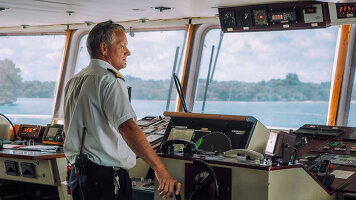
Take a look behind the scenes and see the captain at work, learn how the ship works and enjoy some of the best views onboard. Read more

Keep your fitness up during your cruise in the onboard gym or alleviate and revitalise yourself in the spa. Read more

Whether it's a quick bite to eat or a multi-course evening meal, Heritage Adventurer's all-inclusive dining will satisfy your hunger. Read more
Tour & cruises prices are per person. Prices shown have savings applied, are subject to availability and may be withdrawn at any time without notice. Pricing and trip details are correct at this point in time, however are subject to confirmation at the time of booking and are subject to change by Heritage Expeditions. For cruise itineraries, cabin images are sourced from the cruise-line and should be treated as indicative only. Cabin inclusions, upholsteries and room layout may differ to the image(s) shown depending on the ship selected and your sailing dates.





